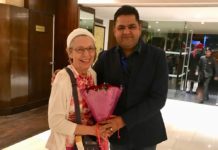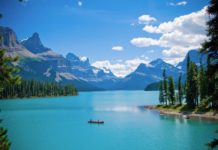
Apparently, the word “pur” on the end of any Indian town or city name means place.
So, Bharatpur, I assume means, the place of Bharat and Jaipur, means the place of Jai.

From Bharatpur, we headed to Jaipur, the pink city, stopping on the way to see a village public school where the kids were sitting on the floor in small outdoor buildings, learning English and other lessons.

We also stopped at Chand Baori, the oldest step well in Rajasthan, built in the 8th and 9th century. This is an impressive structure with a geometric pattern of steps on a square grid.
Steps go down thirteen levels to the water pool at the bottom. This was a place where traders stopped to refresh and refuel their camels and horses and themselves at the equivalent of the local motel.

Across the street, there is also the ruins of a beautiful Harshshat Mata temple. Some of the better decorative pieces from the temple have been salvaged and placed for safety within the historic step-well precincts.
In Jaipur, we started our visit by going to the local Hindu temple, one made of white marble.

The next morning, we went to the Amber Fort, just outside Jaipur. On our way, we paused to see the old city of Jaipur with its lovely pink palace architecture.
We also saw the Albert Hall Museum, an architecturally attractive building, where the first foundation stone was laid in 1878 during a visit of the Prince of Wales.

The building is beautifully lit at night with a dazzling series of changing colours from purple to pink to blue to green.
At the Amber Fort, which is about 11 km outside Jaipur, we took jeeps through the narrow streets, up the hillside to the picturesque fort at the top.
Inside the fort, we found dozens of elephants in a continual parade as they carried tourists for a short ride.
Apparently, the Indian government is working hard to eliminate this practise and get elephants into a sanctuary where they are treated better and have to do less demeaning work and are allowed to live more natural elephant lives.

Inside the fort, we also saw the garden and covered palace rooms and a mix of Indo-Islamic architectural styles including fabulous fresco facade and formal geometric clipped garden.
The fort is a formidable structure that is mirrored beautifully in the lake of water that was only partly filled when we were there but enough to capture the image of the fort perfectly.

Back in Jaipur, we also took time to visit the pink royal city palace and outside the city to a garden and palace complex called Sisodia Rani Ka Bagh built by the Maharaja Sawai Jai Singh for himself and Rani, the princess of Udaipur, in the 1700s.

Her garden was named after her – Sisodia Rani – and is a lovely walled garden with a series of terraces and domed pavilions and temples and contains a mix of Mughal designs and Indian art styles.

The king’s own garden, Raj Niwas Bagh, across the street is equally spectacular with a long wall topped by a series of small pavilions and large central entertainment/ palace quarters.

Unfortunately, the water was turned off and therefore the fountains were not working and the canals were empty.
Water is a major component of this garden and without it, the garden is considerably less dramatic.

The water would have also added moisture to the air and cooled things down as well as provide some “white noise” to hide the sound of the traffic where thousands of motorcycles were streaming into town, being forced this way because they couldn’t use the more convenient tunnel.

Back in Jaipur, we continued shopping and walking around the city palace complex, but this is an exhausting exercise and it was not long before we had to return to the calm and quiet of our hotel.
To get there, we took a tuk-tuk, which put us right in the heart of the honking traffic chaos.
Our driver charged us 100 rupees for a long ride. We ended up paying 200 because we thought he was such a good driver.
It was one of the most exhilarating rides of my life.
swhysall@hotmail.com























